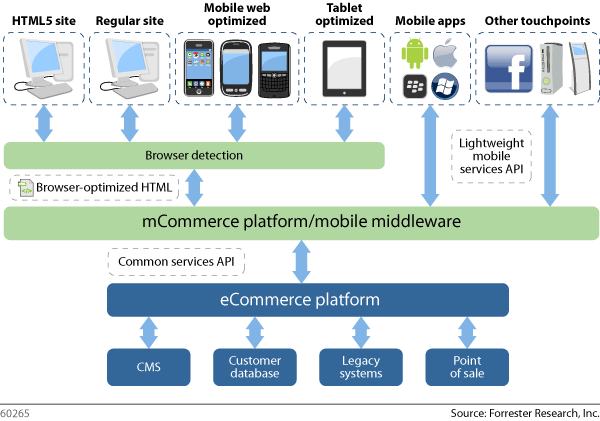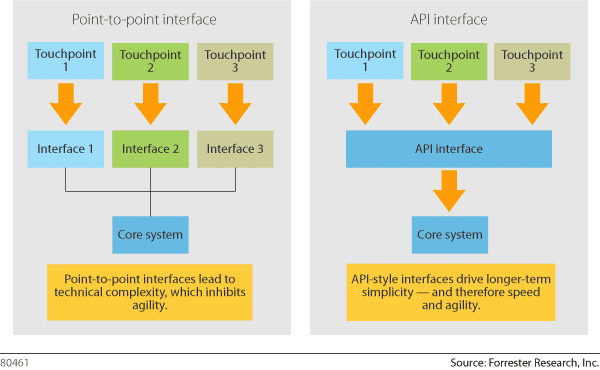APIs should be on any eCommerce company’s short list of strategies for improving the bottom line, particularly when working to monetize the impact of disruptive technologies such as mobile and cloud. By exposing and providing access to the many inter-connected processes involved in eCommerce transactions, Application Programming Interfaces can give your business an edge when adapting to emerging technologies and services as well as constantly evolving consumer preferences and behavior.
eCommerce and APIs
Traditional online ecommerce businesses need to embrace the shift brought on by a new eCommerce paradigm that blends together multiple channels such as social, cloud and mobile for a diversified shopping and purchasing experience. Keeping up with the trend toward everywhere eCommerce requires not only diversifying available shopping touchpoints beyond the now-standard online store, but also guaranteeing a consistent experience regardless of when or how customers interact with different sales channels.
APIs, or application programming interfaces, are the “rules” that allow third-party apps to connect with technology platforms and manage communications between apps and platforms. Because the modern online shopping experience involves so many elements, APIs play a key role in bringing together inputs from multiple sources to create a unified customer experience. Just a few of the many touchpoints in a multichannel purchase process might include:
- mobile applications
- digital entertainment services (including those served interactively via next-generation TVs)
- signage apps
- social commerce apps
- social shopping recommendations
- targeted microsites (subsites)
- cloud widgets
- shops embedded in other websites
- and many other options enabled by cloud technologies and APIs.
As interaction channels expand, customer preferences change. Gene Alvarez, research vice president at Gartner, noted that eCommerce businesses must think ahead and anticipate how context-aware mobile-shopping solutions can help improve their social presence and drive mobile application sales, which are projected to reach 50% of all web sales by 2015. To achieve context awareness across channels, companies must design great shopping experiences and also work with APIs that enable communication with eCommerce platforms and other components at every step of the process.
eCommerce Evolution and APIs
The perennial evolution of the eCommerce universe is influenced by a variety of factors, from disruptive technologies to changes in consumerization trends. In an August 2011 report entitled INTEGRATION CHALLENGES FOR MOBILE COMMERCE by Forrester Research Inc., Senior Analyst Peter Sheldon concluded that future eCommerce architectures must take into account rapid touchpoint growth, while forecasting that burgeoning touchpoint proliferation will make API support a requirement. The analyst stressed the need for a platform and APIs capable of supporting not only cohesive eCommerce experiences across disparate touchpoints but also understanding the way in which consumer usage is changing, particularly with regard to device swapping.
Everywhere eCommerce is becoming a reality at a fast pace. As a result, Forrester Research is advising businesses to consider investments in API frameworks that will be capable of supporting tomorrow’s constantly connected shoppers, regardless of the devices they use to discover research, compare, explore and buy. APIs allow businesses to focus on their core strengths while efficiently leveraging strong eCommerce or mobile commerce platforms to drive a successful purchasing experience.
Touchpoint Proliferation
It may seem easy to say that customer touchpoints are growing, but data on customer habits and preferences clearly support this assertion. According to the August, 2012 Forrester Research Inc. report: “AGILE COMMERCE: KNOW IT WHEN YOU SEE IT” by Principal Analyst Martin Gill:
- Nearly 49% of US and 28% of European online shoppers already use multiple touchpoints when making purchases via the web;
- As many as 38% of US consumers are interested in shopping mash-ups available through in-store kiosks;
- At least 31% of US online adults have used ratings and reviews to help them make purchase decisions;
- According to estimates, in 2017, European mobile commerce revenues are expected to top €19 billion, representing 6.8% of web sales.
Forrester analysts emphasize that agile eCommerce platforms are best suited to help businesses reach consumers in multi-touchpoint-scenarios. Because it would be prohibitive for every company to develop its own eCommerce system for every channel, leveraging a flexible and scalable API designed to streamline technology integration with an eCommerce platform is a crucial part of the agile commerce equation.
API Growth and Advantages
As customer touchpoints expand, API usage is growing just as quickly. Again, the September, 2012 report by Martin Gill of Forrester Research, Inc. entitled: DRIVING AGILE COMMERCE TRANSFORMATION shows how APIs are designed to support speed and agility through simplicity:
Leveraging an API can simplify software development and create a faster, more customized experience for the end user. APIs enable your company to take full control of the shopping experiences you’re offering your customers without developing an in-house eCommerce platform. Ideally, a mature eCommerce API should support and expose core platform capabilities, including the ordering process, merchandising, promotions, customer and subscription management, data administration, and more. Most importantly, an API should provide touchpoint agnostic tools to target consumers effectively, regardless of the platforms, access points, and form factors they may be using.
Tips for Successful API Usage
We’ve seen why multichannel eCommerce is growing and listed some examples of customer touchpoints that need to work together for a great customer experience. Now, let’s highlight some examples of how the Avangate eCommerce API can be used to improve the customer experience and drive purchases.
- Single-click post-sale purchases. It certainly doesn’t get any more frictionless than being able to charge customers instantly, based on the data from an existing order. The Avangate API is used to offer targeted promotional products to existing customers and supports a single-click ordering process, creating a painless and fast purchasing experience.
- Streamlined customer upgrades. Investments in building and maintaining user hubs or customer portals provide a critical channel for increasing revenue and rewarding customer loyalty. Upgrades that are served directly in the user portal simplify the upgrade acquisition process for shoppers while enabling you to reap the benefits of the customer community you have built, as well as foster expanded usage of your product.
- Seamless transition between subscription plans. A painless transition between subscription plans will help your customers easily access premium offerings, while making it as simple as possible for you to highlight upgrades or more powerful products, and earn additional revenue.
- Cross-device purchasing. Create an appropriate purchase experience for every device, with more supplemental offers for the desktop and a shorter purchase path on mobile.
- Control. APIs help optimize the level of investment needed. You control the development, integration, and deployment of your shopping experiences, without making the investment to develop a full eCommerce platform yourself. Additionally, you’ll be able to minimize time-to-market and maximize ROI, providing a great shopping experience at minimum cost.
- Boost sales and revenue. Beyond just controlling costs, APIs also offer the opportunity to tap consumers in new markets by opening up your services through various channels. Expand your audience and sales and revenue will also increase.
- Innovation. Take your shopping experiences to the next level as you see fit. Use an eCommrece API to embed shopping options into your customers’ preferred touchpoints, especially those that bypass the browser, for a simple yet effective way to appeal to consumers.
- Unified, branded mash-ups across touchpoints. APIs help you architect and unify customer-facing shopping experiences by clearly aligning them with your brand. This provides customers with seamless consistency across touchpoints, rather than siloed eCommerce mash-ups.
- Differentiation. Your API-enabled capacity to innovate on top of the core capabilities of an eCommerce platform will contribute to setting you apart from the competition, even if you and your competitors share the same eCommerce provider.
APIs can be leveraged to fuel everywhere eCommerce, opening up platforms and providing innovative solutions to expand the reach of offerings beyond traditional, comfortable boundaries. Innovation built on top of core eCommerce platforms will ultimately serve to differentiate and accelerate your business and help minimize competitor impact on margins.
The need for using APIs will only continue to grow as devices and touchpoints proliferate, so start experimenting with APIs today and achieve agile eCommerce success.







